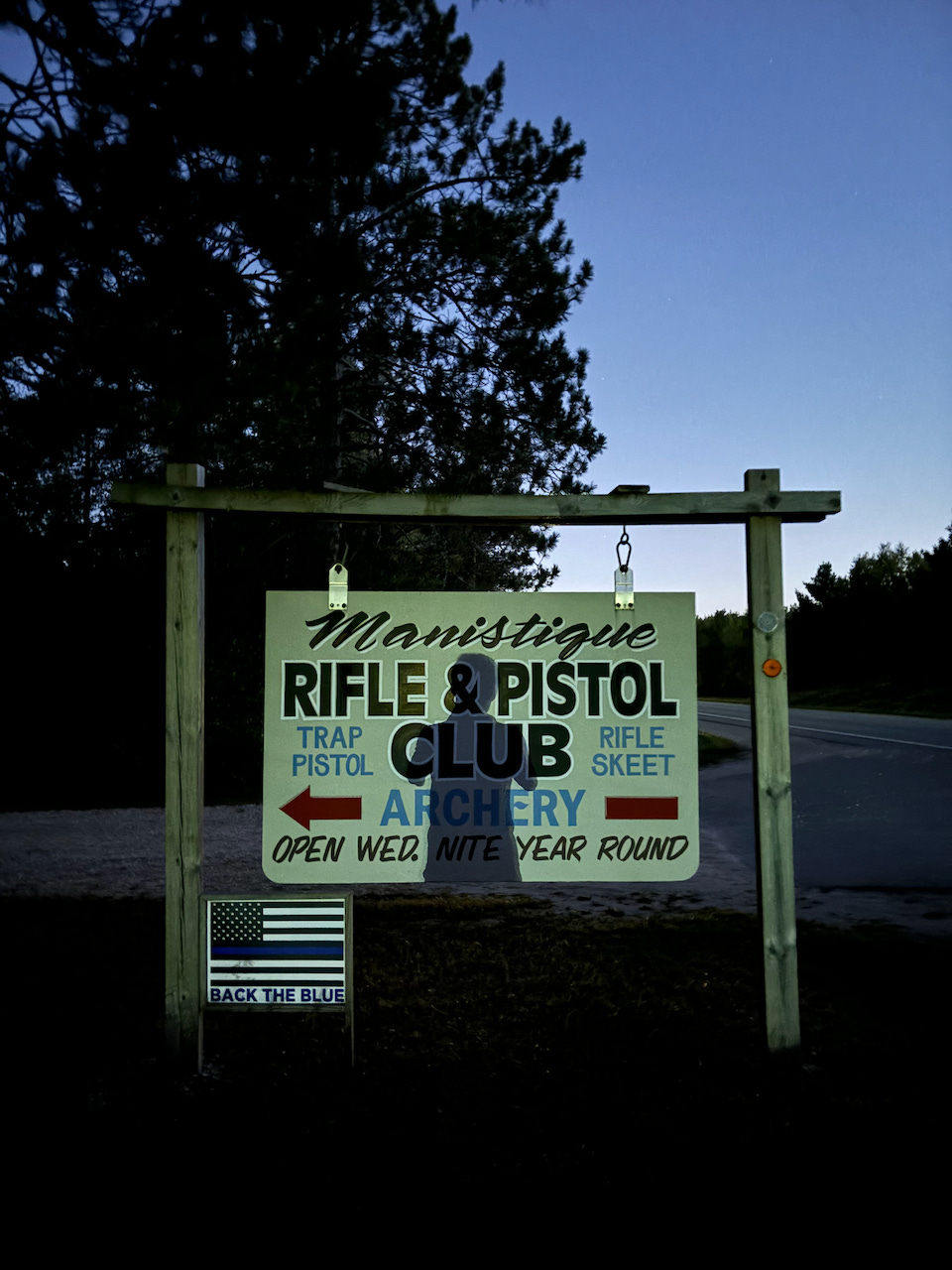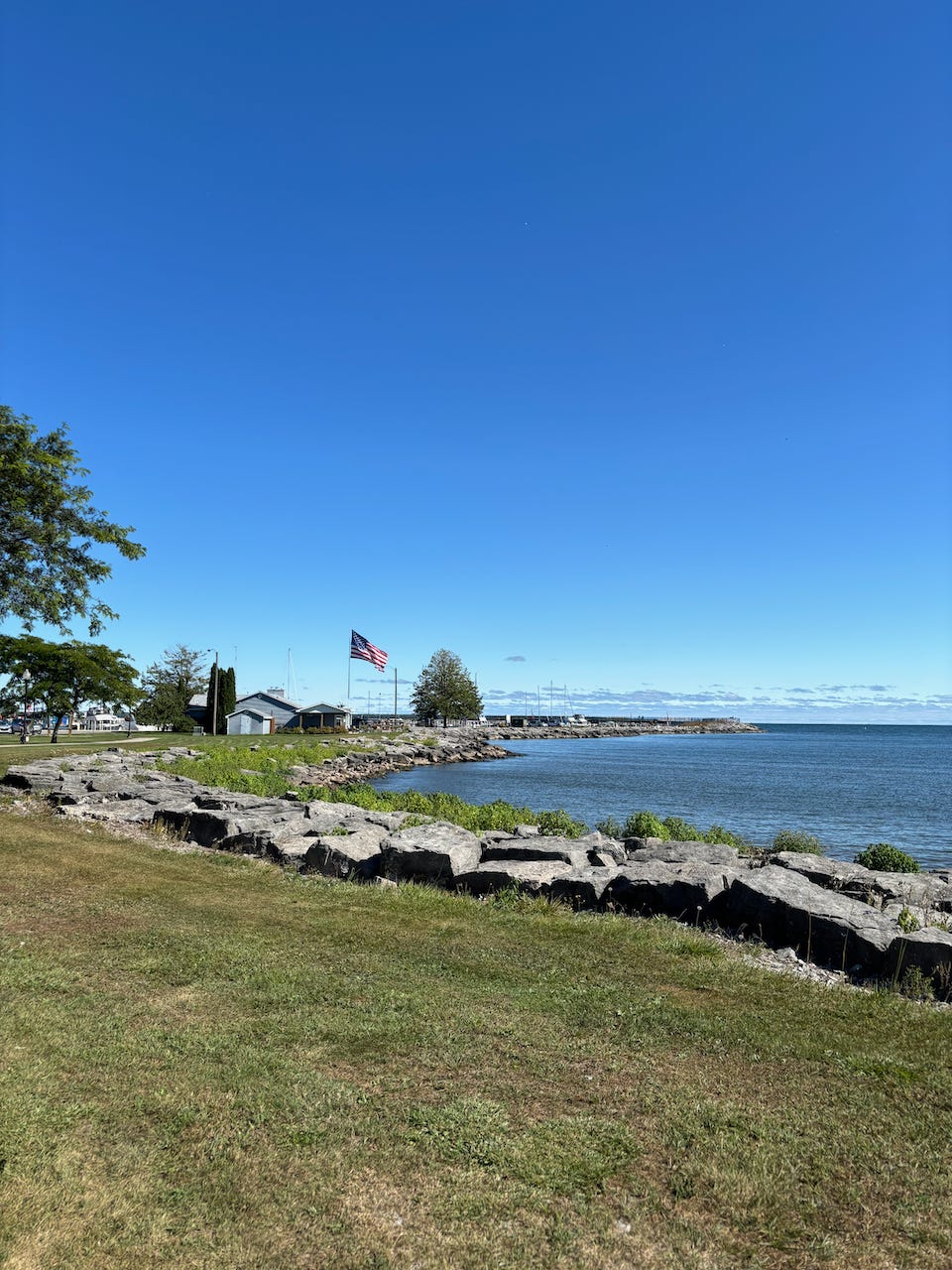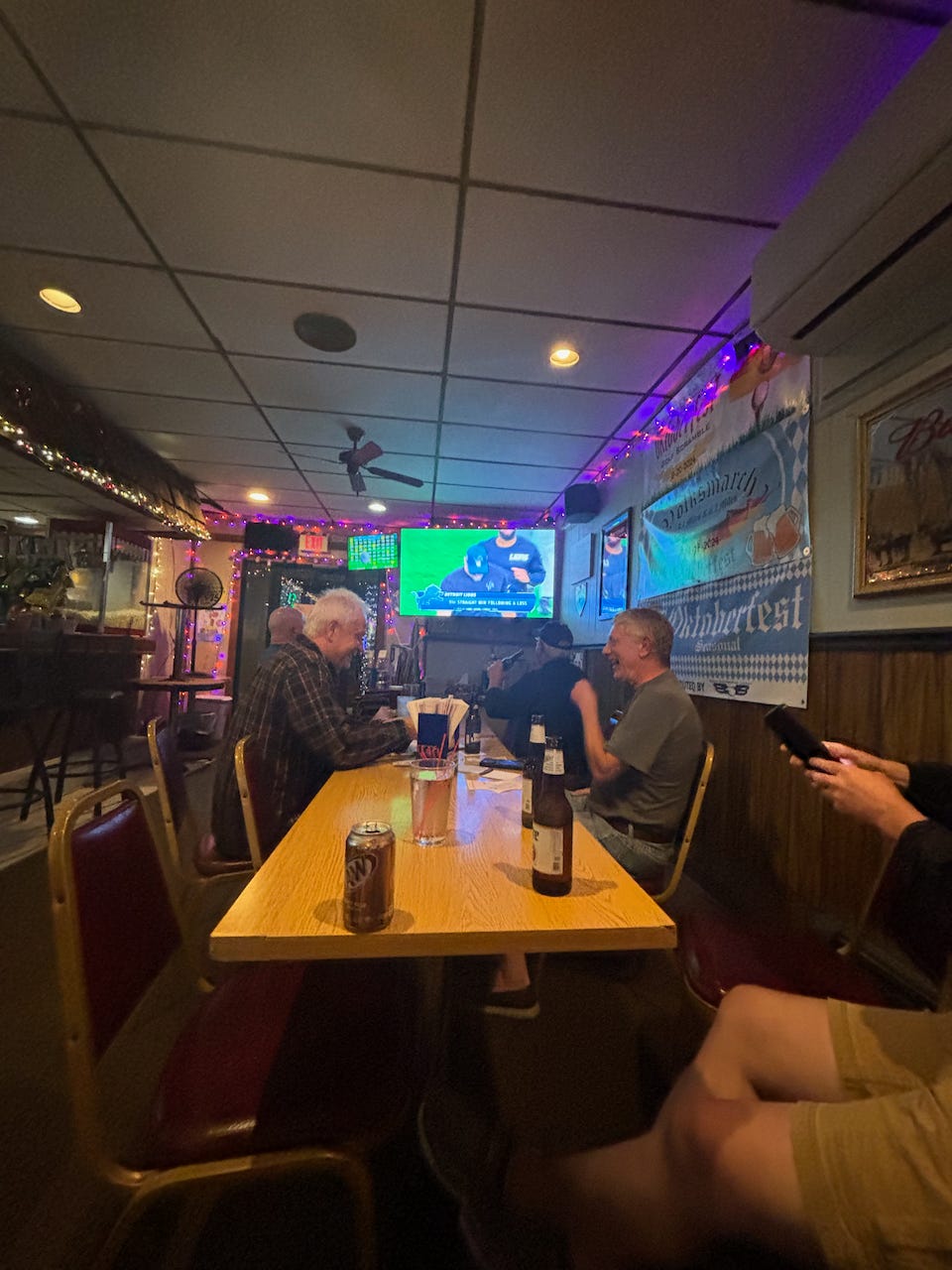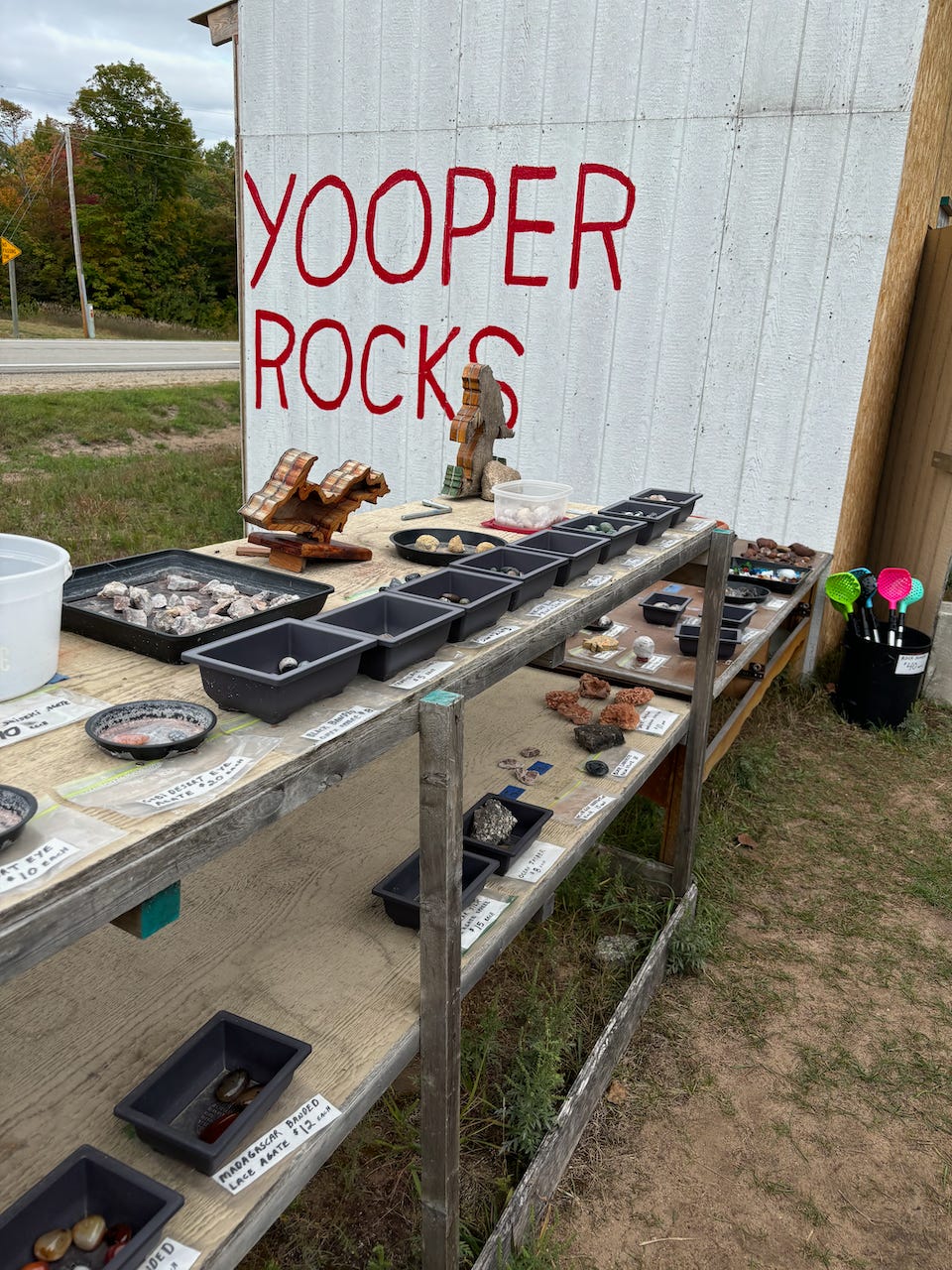MANISTIQUE, Mich. — “You’re not leaving until you shoot a bird.”
Dick’s declaration lingered in my mind as another clay pigeon descended harmlessly toward the grass expanse in front of us, the bruise of his shotgun on my left shoulder blade growing harsher.
I grunted with dissatisfaction. Over my shoulder, he let out a restrained sigh, proceeding to firmly but patiently reposition my fingers and adjust my stance. An animated grandpa decked out in an orange shooter’s vest and cowboy hat, umpteenth whiskey glass of the night snug in his left hand, he’d assigned himself an ambitious goal: coaching me to trap shooting glory. Could I make him proud?
Never in my life have I paid as much attention to roadsides as I have this trip. Midwestern roads, it turns out, burst with surprises. And I mean roads: not neighborhood streets, nor standard-issue highways, but two- or four-lane courses traversing nondescript outlying areas. Every half-mile something eye-catching emerges from the shoulder. Most common are firewood stands, offering valuable campfire fuel and usually operating fully on the honor system. Then, people selling berries and eggs out of their backyards; weekend garage and estate sales; deer feed, live bait, exotic rocks. The almost invariably hand-scrawled advertisements beckon you to make dangerously sharp turns onto narrow dirt paths.
When the trip’s most intriguing roadside attraction yet appeared before me, I’d already had a stimulating day: visiting several scenic lookouts, taking a high-adrenaline boat tour, stopping at a general store for ice cream, driving dirt roads to the famed Big Spring, and lingering in a small town chatting up farmer’s market and art gallery vendors. I try never to turn off “exploration mode” while traveling, but in truth I was ready to take a pizza to go and decompress in my hotel room.
Then, whizzing by at 60, the Manistique Rifle and Pistol Club’s capital-lettered sign shoved itself in my face. The big, black print caught my attention first. I couldn’t help but fixate on the bottom line:
OPEN WED. NITE YEAR ROUND
And Wednesday it was. Instantly, I recalled the impromptu shooting lesson a pack of West Virginian teenagers gave me — a signature moment from last year’s road trip. For the next 45 seconds I ran through a mental checklist of sorts: was my arrival time urgent? (Definitely not.) Would I kick myself if I didn’t at least stop and check it out? (Almost certainly.) Could I make the necessary three-point turn safely? (Yes; the road was empty.) The club was about to find out what happens when someone with essentially zero shooting experience takes an “open” sign really literally.
The pop-pop-pop of shots registered in my ears before I got out of the car. I casually strolled up to a group of muscular guys perched in a semicircle of lawn chairs on an elevated deck, relaxed as can be: legs splayed out, drinks imbibed, basking in the near-perfect evening between their turns shooting. They were quick to crack jokes and legitimately hilarious. When I mentioned watching this year’s Olympic skeet shooting, one piped up immediately: “oh yeah, they’re almost as good as us!”

When it was time for drink refills, they beckoned me inside the club, a sparsely decorated building with a humble bar and low ceilings. An amused regular started introducing me to everybody there; I was served a Squirt soda, which I’d never heard of before. Soon, Dick got behind the bar. Though not the head honcho, he was clearly a seasoned member who could give others orders to follow. Briefed on my story, he made up his mind then and there: I was shooting a bird tonight.
Dick coerced a poor guy named Tom into teaching me the basics while his friend Bill chipped in by lending me earmuffs. Once Dick retrieved his 115-year-old Palmer shotgun, there was no going back. But the challenge became apparent as soon as I picked the gun up: this sport requires precision. Contorting my body into proper form was tough enough; maintaining it while quickly aiming is even harder. You need to keep the gun pinned to your cheek, but my face instinctively lifted itself off of it when I tried to follow the birds’ movements.
Pull! is the command they shout to trigger the audio-activated machine that fires the birds, and let’s just say I gave Dick’s vocal cords a workout. My aim was too low, then off to the right. Lean forward and bend at the waist, Tom suggested. A few times Dick had me simply track the bird without firing, but my form was still a little janky. My competitive instincts had kicked in, yet I remained pessimistic about my chances. Were they seriously going to deplete an entire case of shells just for me?
Then, on my 12th or 13th attempt, a breakthrough. I never saw the impact. Yet there they were, orange fragments scattering through the air in two directions. Sweet satisfaction for me. A big whoop from Dick. And a memory to cherish forever.
My tour of Michigan began a week earlier in well-kept Holland, the anchor of a distinct community traceable to Dutch Calvinist separatists.
The people there are subdued, with a reflexive disdain for vulgarity that’d feel familiar to anyone with Utahn relatives. Stability and family values are major sources of pride; restraint is often the name of the game, even for teenagers (one told me she cared a lot about purity). Quaint businesses dot the shopping-friendly main drag.1
After passing through the rest of Michigan, it became clear to me that Dutch country is a cultural bubble, one that presents a Rorschach test: does it stifle individuality, or safeguard core principles? It feels like a place where you need to conform culturally in order to reap the full benefits of community. But there are plenty of people it’s working well for: at an iconic local ice cream stand, I witnessed an endless stream of happy-looking young couples wait for unfussy soft-serve creations they shared outside in the misty night. Something tells me they wouldn’t change much.
The small cities of mid-Michigan are unassuming and gritty in parts. Most people I met expressed personal contentment and optimism for their region. Like in industrial Ohio, the scrappy nature of these places precludes any hints of pretentiousness from showing up.
I knew I wanted to watch the week’s Lions game with lifelong fans, so I drove the hour and 15 minutes to Bad Axe, located in the largely agricultural and rural Thumb region. The sidewalks were desolate, but the bar was inviting — a pattern that recurred before my time in Michigan was up. The owner, a large man with a scraggly lily-white beard and an Aidan Hutchinson shirsey, sat with five of his regulars, one with an accent so strong I’d have bet the farm he was Canadian if someone zapped my brain’s compass right before he started talking. Everyone in the building was on a first-name basis. In between outlining plans for the coming winter’s shuffleboard league and filling out Keno slips, they directed only a few expletives toward the TV as the Lions wrapped up a relatively drama-free win; afterward, the crew pooled together $800 to bet on the Sunday night game2, and I got a Facebook friend request.
The transition from mid-Michigan to northern Michigan marked the first truly rural stretch of the trip. Roads narrowed and grew windier; the aforementioned potpourri of roadside attractions morphed into thickly wooded forest interspersed with mailboxes. The further north I went, the more I saw houses with personalized signage displaying family names or a state motif.
In the fabled Upper Peninsula, I found a culture both distinct and intact. Bumper stickers proclaiming the U.P. as the 51st state feel only somewhat ironic. I sampled the range of local delicacies: a pasty, popularized by hardy miners, a classic Finnish breakfast of pannukakku with raspberry sauce and nisu toast, donuts with thimbleberry frosting. High school athletic teams have names like the Hematites and Copper Kings, reflecting the region’s mining heritage.
It is an undeniably beautiful place. The Pictured Rocks and Big Spring are among the most unique natural sights I’ve seen. The remote city of Houghton has its own haunting beauty, with echoes of Appalachia’s hollers: it’s small and dense, hemmed in by steep hills. Touring a former iron mine in Ishpeming, 90 minutes southeast, it was hard not to feel deja vu from the interactive coal mine I visited in West Virginia last year.
Coming into the U.P., I wondered whether outsider tourists had imposed their outdoorsy ways on the place, or if the locals were just as enthusiastic about their waterfalls, forests, and lake time. (It’s the latter.) It’s the kind of place where you expect people to use “my land” instead of “my house.”
Leaving the state, it struck me: not a single person I approached refused to talk. I often remark that strangers across the country are more willing to chat than most people assume. But this was exceptional: everyone from an 82-year-old former Parks Service employee hanging out at a bookstore in the late evening to a bashful medical school student in a quiet coffee shop gave me some of their time. Millwrights working on turbines, aspiring teachers and social workers, a roofer, a volleyball coach, a former musician who toiled in the Chicago jazz scene before becoming a programmer — Michiganders, to a man, were extremely pleasant to be around. For that I am truly grateful and inspired to spread their spirit to others.
Michiganders’ appreciation for outdoor activities like hunting and fishing cuts across age, gender, and geography, and is far less correlated with any ideological attributes than a city dweller may assume.
One girl I spoke to told me she’d be going to the ice cream shop her friend worked at to say hi. In Bay City an antique-store cashier I met encouraged me to pop by the bar she worked at later. The “go see your friends at work because you know they’ll be there” vibe is prominent.
I heard a radio ad targeted toward young people, promising to give them training to get them driving trucks within four weeks. That ad is very unlikely to reach the Boston airwaves.
Lots of older people I’ve met ask me what my last name is. Many use the question as a jumping-off point to gab about ancestry, which I find delightful. What fascinates me: I sense most Gen Zers would register that question as rather inappropriate, but it rolled off the tongue as naturally as a greeting to the seniors I’ve spoken with.
When I enter an obviously unfamiliar place like Pete’s, the reception is never condescending or “why the hell are you here?” and I actually get treated as if I were a local, despite the unspoken knowledge I’m not.
The accent is real! They say “eh?” in the U.P. and twist their o’s and a’s. “County” becomes something more like “gouny”, “bag” sounding like “beg” is a thing, etc.
Michiganders hate, hate Ohio. One guy in Alpena was only half joking when he said “they’re beneath us.”3
I haven’t been given a hard time for ordering soda at any bars. Given how intense I’d heard the drinking culture purported to be, this has been a really pleasant surprise.
The urban heat island effect and density of buildings means I rarely ever see fog as thick and dew as pervasive as I’ve seen on this trip.
People who are too afraid to drive over the Mackinac Bridge are called “timmies,” derived from “timid,” which is delightful.
High school football is just as big a deal in Michigan as it is in Ohio. “As always, Neg Nation, go, Negaunee, go!” is how one announcer on the local pop radio station ended a promotion for the week’s game.
Best thing I ate: the banana pudding from Tia’s Soul in Saginaw. It had the perfect level of sweetness, consistent texture, and fresh wafers — ranking it among the very best I’ve had, which is saying something since I spent time in the Deep South. The fried chicken was on point, too.
Honorable mention goes to the Klompen cake at deBoer’s in Holland, which had all of the good attributes of a pancake without any of the bad (burnt taste, dryness, bready texture). Like at Tia’s, everything was good; the almond coffee cake was incredibly dense with a decadent topping, and the Dutch pig-in-blanket pastry had a satisfying flakiness that’d rival any good chausson aux pommes.


It is fascinating, though, how the neatly patterned sidewalks give way rapidly to metal processing facilities shockingly close to the main drag, heaps of scrap metal visible from the sidewalk.
They bet on the Chiefs (-3.5) to cover against the Falcons, and won.
I imagine part of the reason why this rivalry is still alive and well is that it’s based on geography rather than specific players. The boos at Fenway were deafening when A-Rod or Jeter came up to bat, but now that barely anyone in the stands knows the Yankee lineup from front to back, things have gotten tamer.

















